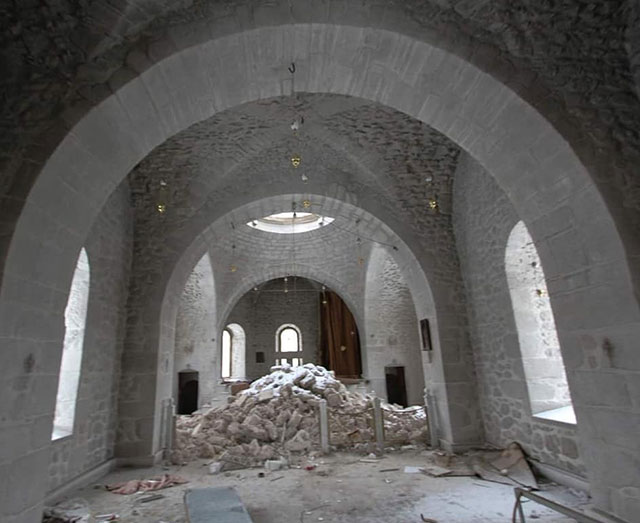Hovhannes Mkrtich or Kanach Zham Armenian Church of Shushi was completely destroyed by the Azerbaijanis. Now it is being converted into an Orthodox church under the name of renovation.
Among the monuments of Shoushi, the Church of St. John the Baptist in the Upper District or the Green Church is of particular interest. It is called “Green Church” because the dome of the church used to be green. There is an inscription about the year of construction above the entrance to the bell tower of the church.
“Babayan Stepanos Hovhannes. In memory of the deceased brother-Baptist, 1847” Recently, a user of social networks Elnur Allahverdiev returned to the thankless work of Russification of the “Green Church”. It should be noted that the rush of russification of the church is not a new phenomenon for Azerbaijan. At one time, Fuad Akhundov unjustifiably considered the church “Russian Orthodox”.In the mid-1960s, a decision was made in Baku to expand the Armenian part of the city in order to expand the “living space” for Azerbaijani settlers, of course, to remove the Armenian traces of Shushi. During this time, three surviving Armenian churches and one Russian church were destroyed, as well as several Armenian cemeteries with beautiful khachkars and monuments. The Green Church, which Fuad Akhundov considers “Russian Orthodox” without reason, has turned into a gallery.
What is the background of the church of John the Baptist? There are evidences according to which in 1840, by a special order of the authorities, all Armenians living in the Muslim environment of Nerkin Tag /Lower region / moved to Verin Tag / Upper region /. 56 families (ՀԱԱ Arm. Ֆ. 56. ց. 1 .. գ 2199. թ .1-2) who lived there had a church “Surb Astvatsatsin” / Holy Mother of God / with stone and wood covering, which speaks of the overwhelming majority of the Armenian population living in the area. The document says that the Armenians were oppressed by the Muslims, which led to their resettlement (ՀԱԱ Arm. Ֆ. 56. ց. 1 .. 99 2199. թ .1 -2) …
From the same document it is clear that after moving to Upper district a wooden chapel was built in the new place, which remained until 1848, when the stone church of John was built in its place. It is interesting that for a long time this church was called the Church of the Holy Mother of God in the Upper District. In the lower part of the city, almost on the site of the now covered market, there was a Byzantine Orthodox church built in classical Russian architectural motives for the garrison of Russian officials, which, unfortunately, has not survived.
We will return to the temple separately.
As for Elnur’s thoughts about a dome similar to the dome of an Orthodox church, this was due only to the influence of the architectural style of that time, which, however, did not survive when the church, destroyed during the First Artsakh War, was later restored.
Elnur may assert himself tomorrow with an attempt to Russify Dadivank, how do we know? Occupied by Azerbaijan.





















































